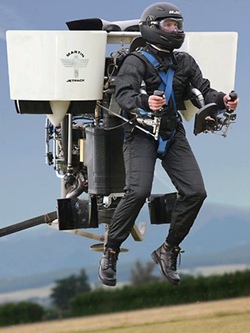“He’d fly through the air with the greatest of ease,
That daring young man on the flying trapeze.”
And that was written in 1867, but now we don’t even need the trapeze with a New Zealand company behind an ambitious aeronautical project called the Martin Jetpack, a strap-on personal flying machine, now in the final stages of development, with the first machines to be dispatched for solo flights by the end of the year.
Military agencies, border control and rescue organizations in the US will be the first to use the $75,000 personal flying device.
Inventor Glenn Martin predicts it will be just 18 months before other wealthy enthusiasts get their delivery.
 Martin Jetpack
Martin Jetpack
The jetpack resembles two leaf blowers welded with a two liter, jet-powered engine that can reach 100 km/h at heights of up to 50 meters, and it carries enough fuel for 30 minutes of flight.
It is categorized as a microlight so it has many restrictions on its use and cannot be taken into the city centers; however, there are hopes that this classification this may change under US law.
Martin’s machine, lauded as Time magazine’s most anticipated invention last year, has been more than three decades in the making.
The Christchurch man began tinkering with the concept in the 1970s, inspired by the limited success of the US Bell Rocket Belt, which stayed airborne for just 26 seconds before crashing.
It was designed to be the “simplest aircraft in the world,” said inventor Martin, and “as Newton said, for every action there is an equal and opposite reaction. So when you shoot lots of air down very fast you go up and you’re flying.”
According to Martin, it is safe (or as safe as anything that flies can be, I suppose) and they look for safety in design, operations, through pilot training and have incorporated structural design and emergency systems that minimize the impact of an accident. The Martin Jetpack’s extensive safety features include a rapid deploying parachute, roll cage structure and shock absorbing undercarriage.
An unmanned remote-controlled (UAV) version is well advanced in its development with field trials expected to begin in the second quarter of 2011.




